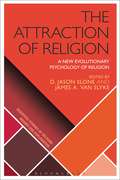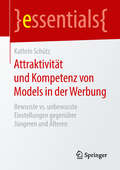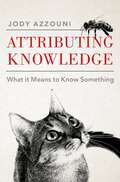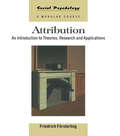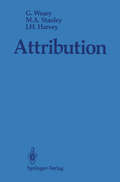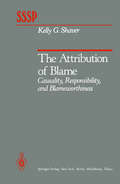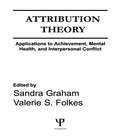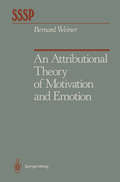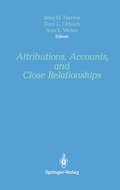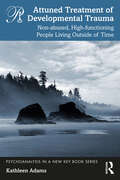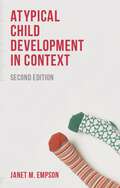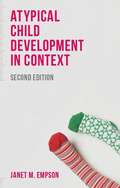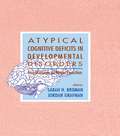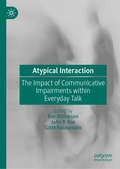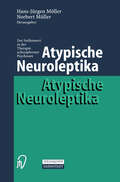- Table View
- List View
The Attraction of Religion: A New Evolutionary Psychology of Religion (Scientific Studies of Religion: Inquiry and Explanation)
by D. Jason Slone James A. SlykeReligion is an evolutionary puzzle. It involves beliefs in counterfactual worlds and engagement in costly rituals. Yet religion is widespread across all human cultures and eras. This begs the question, why are so many people attracted to religion? In The Attraction of Religion, essays by leading scholars in evolutionary psychology, anthropology, and religious studies demonstrate how religion may be related to evolutionary adaptations because religious commitments involve fitness-enhancing behaviours that promote reproduction, kinship, and social solidarity. Could it be that religion is wide-spread, at least in the modern world, because it helps to facilitate cooperative breeding? International contributors explore the philosophical and theoretical arguments for and against the use of costly signalling, sexual selection, and related theories to explain religion, and empirical findings that support or disconfirm such claims. The first book-length treatment that focuses specifically on costly signalling, sexual selection, and related evolutionary theories to explain religion, The Attraction of Religion will be an important contribution to the field and will be of interest to researchers in the fields of evolutionary psychology, religion and science, the psychology of religion, and anthropology of religion.
Attraktivität und Kompetenz von Models in der Werbung: Bewusste vs. unbewusste Einstellungen gegenüber Jüngeren und Älteren (essentials)
by Kathrin SchützDieses essential zeigt, wie sich neben jüngeren auch ältere Models gezielt in der Werbung einsetzen lassen und welche Altersgruppe für welche Produkte und Dienstleistungen geeignet ist. Passen jüngere Models generell besser zu Produkten für jüngere Konsumenten und gilt dies im Umkehrschluss auch für ältere Models? Möchten Jüngere und Ältere von Personen ihres Alters angesprochen werden oder kommt es auf die Passung zwischen Model und Produkt an? Die Autorin gibt einen Überblick über wissenschaftliche Erkenntnisse und untersucht aus Sicht der Jüngeren als auch der Älteren bewusste und unbewusste Einstellungen im Zusammenhang mit Altersstereotypen.
Attraktivität von Strafgefangenen: Warum Frauen sich zu Straftätern hingezogen fühlen (BestMasters)
by Désirée LabuschDésirée Labusch bietet eine vollständige Zusammenfassung der bisher bestehenden Untersuchungen über Frauen, die einen Partner wählen, der zum Zeitpunkt des Kennenlernens inhaftiert ist. Unter besonderer Berücksichtigung ihrer evolutionären Adaptivität und ihres austauschtheoretischen Nutzens werden die 13 wichtigsten, vor allem klinischen, psychoanalytischen, sozialisations- und persönlichkeitspsychologischen Erklärungsansätze sowohl inhaltlich als auch empirisch differenziert analysiert. Die Ergebnisse zeigen, dass es zwei verschiedene Typen von Strafgefangenen gibt, die von Frauen als attraktiv empfunden werden. Diese Frauen unterscheiden sich in ihren Persönlichkeitseigenschaften und Sozialisationserfahrungen.
Attraverso il microscopio: Neuroscienze e basi del ragionamento clinico (I blu)
by Davide SchifferIl libro prende le mosse dai pensieri di un giovane che alla maturità liceale si trova affascinato dalla cultura dei classici greco-latini, dai rudimenti filosofici e dall’impatto con le scienze fisiche e naturali. Il latino e i suoi naturalisti hanno suscitato un fervore verso la Botanica Sistematica che lo riporta a Linneo e quindi alla conoscenza del mondo naturale, all’esperienza della denominazione dell’esistente come conoscenza e quindi agli universali di Guglielmo d’Occam. La scelta della facoltà di Medicina fungerà da mediazione fra la filosofia, vista come via alla verità, e la biologia con il grande mistero dell’uomo nella sua dualità di mente/corpo. L’incontro con il microscopio aprirà la strada all’approfondimento della biologia, ma anche alla ricerca dei significati e delle interpretazioni del mondo. I meccanismi della percezione, visiva in particolare, nelle articolazioni della Gestaltpsychologie, e i suoi rapporti con il mondo interiore, sia quello della memoria esplicita che della memoria implicita, sono affrontati nell’esplorazione del mondo attraverso il microscopico e nella ricerca di una obiettività scientifica. Locke e Kant, Popper e Heidegger fanno da contraltare a Ramon y Cajal, Golgi, Kandel, Heisenberg, mentre la semiotica illumina e confonde sull’importanza del linguaggio per la conoscenza. Il segno e il suo riconoscimento si trasferiscono nella scienza attraverso l’inter-soggettività e il linguaggio appare come l’unico modo di penetrare l’esistente. Il libro si dilunga sull’origine di certe denominazioni in patologia tratte dalla vita quotidiana, sull’antropomorfismo spesso applicato agli oggetti del campo microscopico, sempre illustrati su base fenomenologica e psicologica.
Attributing Knowledge: What It Means to Know Something
by Jody AzzouniIn Attributing Knowledge, Jody Azzouni challenges philosophical conventions about what it means to know something. He argues that the restrictive conditions philosophers place on knowers only hold in special cases; knowledge can be attributed to babies, sophisticated animals (great apes, orcas), unsophisticated animals (bees), and machinery (drones, driverless cars). Azzouni also gives a fresh defense of fallibilism. Relying on lexical semantics and ordinary usage, he shows that there are no knowledge norms for assertion or action. He examines everyday cases of knowledge challenge and attribution to show many recent and popular epistemological positions are wrong. By providing a long-sought intelligible characterization of knowledge attribution, Azzouni explains why the concept has puzzled philosophers so long, and he solves longstanding and recent puzzles that have perplexed epistemologists--including the dogmatism paradox, Gettier puzzles, and the surprise-exam paradox. "This is a terrific book, full of surprises. For instance, Chapter 9 is full of points that are original, insightful, and useful in helping to resolve stale debates. I especially liked the points that we don't ordinarily describe someone as losing knowledge by gaining defeating evidence, that "knows" is vague and tri-scoped, that vagueness needn't be explained by appeal to precise metasemantic machinery, and that Williamson's anti-luminosity argument founders on the fact that knowledge doesn't require confidence. Bravo!" --Ram Neta, University of North Carolina, Chapel Hill Praise for Jody Azzouni's Ontology without Borders: "Azzouni offers a very strong drink, proposing that we do without central elements of what almost anyone would call logic or ontology. His arguments are serious and wide-ranging. If he's right, the reader will have learned something very important. If he's wrong, then the reader who figures out how he went wrong will also have learned something very important. Not every book has this feature." --Michael Gorman, The Catholic University of America
Attributing Knowledge: What It Means to Know Something
by Jody AzzouniIn Attributing Knowledge, Jody Azzouni challenges philosophical conventions about what it means to know something. He argues that the restrictive conditions philosophers place on knowers only hold in special cases; knowledge can be attributed to babies, sophisticated animals (great apes, orcas), unsophisticated animals (bees), and machinery (drones, driverless cars). Azzouni also gives a fresh defense of fallibilism. Relying on lexical semantics and ordinary usage, he shows that there are no knowledge norms for assertion or action. He examines everyday cases of knowledge challenge and attribution to show many recent and popular epistemological positions are wrong. By providing a long-sought intelligible characterization of knowledge attribution, Azzouni explains why the concept has puzzled philosophers so long, and he solves longstanding and recent puzzles that have perplexed epistemologists--including the dogmatism paradox, Gettier puzzles, and the surprise-exam paradox. "This is a terrific book, full of surprises. For instance, Chapter 9 is full of points that are original, insightful, and useful in helping to resolve stale debates. I especially liked the points that we don't ordinarily describe someone as losing knowledge by gaining defeating evidence, that "knows" is vague and tri-scoped, that vagueness needn't be explained by appeal to precise metasemantic machinery, and that Williamson's anti-luminosity argument founders on the fact that knowledge doesn't require confidence. Bravo!" --Ram Neta, University of North Carolina, Chapel Hill Praise for Jody Azzouni's Ontology without Borders: "Azzouni offers a very strong drink, proposing that we do without central elements of what almost anyone would call logic or ontology. His arguments are serious and wide-ranging. If he's right, the reader will have learned something very important. If he's wrong, then the reader who figures out how he went wrong will also have learned something very important. Not every book has this feature." --Michael Gorman, The Catholic University of America
Attribution: An Introduction to Theories, Research and Applications (Social Psychology: A Modular Course)
by Friedrich FörsterlingAttribution concerns the scientific study of naive theories and common-sense explanations. This text provides a thorough and up-to-date introduction to the field, combining comprehensive coverage of the fundamental theoretical ideas and most significant research with an overview of more recent developments. The author begins with a broad overview of the central questions and basic assumptions of attribution research. This is followed by discussion of the ways in which causal explanations determine reactions to success or failure and how our causal explanations of other people's actions shape our behaviour toward them. The manner in which attributions may shape communication, and how people often quite indirectly communicate their beliefs about causality, is also explained. Finally, the issue of changing causal connections in training and therapy is addressed. With end of chapter summaries, further reading and exercises to illustrate key attribution phenomena, Attribution will be essential reading for students of social psychology and associated areas such as personality, educational, organisational and clinical psychology.
Attribution: An Introduction to Theories, Research and Applications (Social Psychology: A Modular Course)
by Friedrich FörsterlingAttribution concerns the scientific study of naive theories and common-sense explanations. This text provides a thorough and up-to-date introduction to the field, combining comprehensive coverage of the fundamental theoretical ideas and most significant research with an overview of more recent developments. The author begins with a broad overview of the central questions and basic assumptions of attribution research. This is followed by discussion of the ways in which causal explanations determine reactions to success or failure and how our causal explanations of other people's actions shape our behaviour toward them. The manner in which attributions may shape communication, and how people often quite indirectly communicate their beliefs about causality, is also explained. Finally, the issue of changing causal connections in training and therapy is addressed. With end of chapter summaries, further reading and exercises to illustrate key attribution phenomena, Attribution will be essential reading for students of social psychology and associated areas such as personality, educational, organisational and clinical psychology.
Attribution
by Gifford Weary Melinda A. Stanley John H. HarveyThis book initially was conceived in 1986 by Weary and Harvey as a revi sion and update of their 1981 Perspectives on Attributional Processes (pub lished by Wm. C. Brown," Dubuque, Iowa). However: toe extensive nature of recent work on attributional processes and the opportunity to collabo rate with Melinda Stanley as a coauthor led to a plan to develop a more comprehensive work than the 1981 book. It definitely is an amalgam of our interests in social and clinical psychology. It represents our commitment to basic theoretical and empirical inquiry blended with the applications of ideas and methods to understanding attribution in more naturalistic set tings, and as it unfolds in the lives of different kinds of people coping with diverse problems of living. The book represents a commitment also to the breadth of approach to attribution questions epitomized by Fritz Heider's uniquely creative mind and work in pioneering the area. To us, the attribu tional approach is not a sacrosanct school of thought on the human condi tion. It is, rather, a body of ideas and findings that we find to be highly useful in our work as social (JH and GW) and clinical (GW and MS) psychology scholars. It is an inviting approach that, as we shall describe in the book, brings together ideas and work from different fields in psychology-all concerned with the pervasive and inestimab1e importance of interpretive activity in human experience and behavior.
The Attribution of Blame: Causality, Responsibility, and Blameworthiness (Springer Series in Social Psychology)
by K.G. ShaverHow can we identify the causes of events? What does it mean to assert that someone is responsible for a moral affront? Under what circumstances should we blame others for wrongdoing? The related, but conceptually distinct, issues of causality, responsibility, and blameworthiness that are the subject of this book play a critical role in our everyday social encounters. As very young children we learn to assert that "it wasn't my fault," or that "I didn't mean to do it." Responsibility and blame follow us into adulthood, as personal or organizational failings require explanation. Although judgments of moral accountability are quickly made and adamantly defended, the process leading to those judgments is not as simple as it might seem. Psychological research on causality and responsibility has not taken complete advantage of a long tradition of philosophical analysis of these concepts. Philosophical discussions, for their part, have not been sufficiently I1ware of the psychological realities. An assignment of blame is a social explanation. It is the outcome of a process that begins with an event having negative consequences, involves judgments about causality, personal responsibility, and possible mitigation. The result can be an assertion, or a denial, of individual blameworthiness. The purpose of this book is to develop a comprehensive theory of how people assign blame.
Attribution Theory: Applications to Achievement, Mental Health, and Interpersonal Conflict
by Sandra Graham Valerie S. FolkesThis unusual volume begins with a historical overview of the growth of attribution theory, setting the stage for the three broad domains of application that are addressed in the remainder of the book. These include applications to: achievement strivings in the classroom and the sports domain; issues of mental health such as analyses of stress and coping and interpretations of psychotherapy; and personal and business conflict such as buyer- seller disagreement, marital discord, dissension in the workplace, and international strife. Because the chapters in Attribution Theory are more research-based than practice- oriented, this book will be of great interest and value to an audience of applied psychologists.
Attribution Theory: Applications to Achievement, Mental Health, and Interpersonal Conflict
by Sandra Graham Valerie S. FolkesThis unusual volume begins with a historical overview of the growth of attribution theory, setting the stage for the three broad domains of application that are addressed in the remainder of the book. These include applications to: achievement strivings in the classroom and the sports domain; issues of mental health such as analyses of stress and coping and interpretations of psychotherapy; and personal and business conflict such as buyer- seller disagreement, marital discord, dissension in the workplace, and international strife. Because the chapters in Attribution Theory are more research-based than practice- oriented, this book will be of great interest and value to an audience of applied psychologists.
An Attributional Theory of Motivation and Emotion (Springer Series in Social Psychology)
by Bernard WeinerFor a long time I have had the gnawing desire to convey the broad motivational sig nificance of the attributional conception that I have espoused and to present fully the argument that this framework has earned a rightful place alongside other leading theories of motivation. Furthermore, recent investigations have yielded insights into the attributional determinants of affect, thus providing the impetus to embark upon a detailed discussion of emotion and to elucidate the relation between emotion and motivation from an attributional perspective. The presentation of a unified theory of motivation and emotion is the goal of this book. My more specific aims in the chapters to follow are to: 1) Outline the basic princi ples that I believe characterize an adequate theory of motivation; 2) Convey what I perceive to be the conceptual contributions of the perspective advocated by my col leagues and me; 3) Summarize the empirical relations, reach some definitive con clusions, and point out the more equivocal empirical associations based on hypotheses derived from our particular attribution theory; and 4) Clarify questions that have been raised about this conception and provide new material for still further scrutiny. In so doing, the building blocks (if any) laid down by the attributional con ception will be readily identified and unknown juries of present and future peers can then better determine the value of this scientific product.
Attributions, Accounts, and Close Relationships
by Ann L. Weber Terri L. Orbuch John H. HarveyATTRIBUTIONS, ACCOUNTS AND CLOSE RELATIONSHPIS documents attributional and accounts approaches to the study of close relationships. Issues of focus include communication pro- blems in marriage and their relationship with causal attri- butions; marital violence and its relationship with early learning experience; ego-defensive attribution and excuse- making in couples and with respect to medical problems; and attributions about transitions in relationships.
Attuned Treatment of Developmental Trauma: Non-abused, High-functioning People Living Outside of Time (Psychoanalysis in a New Key Book Series)
by Kathleen AdamsThis book takes a painstaking look at developmental trauma as it manifests in group, individual, and combined psychotherapies, tracking the growth of non-abused individuals who have courageously addressed overwhelming childhood experiences to make sense of the chaos in their lives. The cumulative impact of repetitive stress, fear, and shame in childhood wreaks havoc on the developing brain, resulting in a life-long vulnerability to anxiety, despair, and dissociative moments that are often described as developmental trauma. Adverse childhood experiences are often overlooked by therapists. This book focuses specifically on the profound suffering of high-functioning private-practice patients who manifest developmental trauma from chronic shock, shame, and neglect. Adams offers a synthesis of diverse theoretical worlds in her study of adaptations to cumulative trauma, namely, relational psychoanalysis, the British school of object relations, trauma theory, neuroscience and interpersonal neurobiology, developmental psychopathology, and attachment theory. Using richly detailed clinical material, this book provides invaluably clear examples to illustrate the effects of disorganized states in infancy, making it essential reading for psychoanalysts, psychotherapists and clinical psychologists working with traumatized patients.
Attuned Treatment of Developmental Trauma: Non-abused, High-functioning People Living Outside of Time (Psychoanalysis in a New Key Book Series)
by Kathleen AdamsThis book takes a painstaking look at developmental trauma as it manifests in group, individual, and combined psychotherapies, tracking the growth of non-abused individuals who have courageously addressed overwhelming childhood experiences to make sense of the chaos in their lives. The cumulative impact of repetitive stress, fear, and shame in childhood wreaks havoc on the developing brain, resulting in a life-long vulnerability to anxiety, despair, and dissociative moments that are often described as developmental trauma. Adverse childhood experiences are often overlooked by therapists. This book focuses specifically on the profound suffering of high-functioning private-practice patients who manifest developmental trauma from chronic shock, shame, and neglect. Adams offers a synthesis of diverse theoretical worlds in her study of adaptations to cumulative trauma, namely, relational psychoanalysis, the British school of object relations, trauma theory, neuroscience and interpersonal neurobiology, developmental psychopathology, and attachment theory. Using richly detailed clinical material, this book provides invaluably clear examples to illustrate the effects of disorganized states in infancy, making it essential reading for psychoanalysts, psychotherapists and clinical psychologists working with traumatized patients.
Atypical Antipsychotics (Milestones in Drug Therapy)
by Bart A. Ellenbroek Alexander R. CoolsThe introduction of chlorpromazine in 1953, and haloperidol in 1958, into clinical practice dramatically altered the therapy of schizophrenic patients. Although representing by no means a cure for this severe psychiatric ill ness, it allowed, for the first time, to adequately control the severe hallu cinations and delusional beliefs which prevent these patients from leading a more or less independent life. Indeed these antipsychotics (and the many congeners that were to follow) significantly reduced the number ofchronic schizophrenic inpatients in psychiatric clinics all over the world. However soon after their introduction it became clear that, like all other available drugs, antipsychotics were by no means miracle drugs. In fact, two major problems appeared. First, the antipsychotics had very little effect on the so-called negative or defect symptoms, like social isolation, apathy and anhedonia, and secondly virtually all antipsychotics produced a number of side-effects, of which the neurological (often called extra pyramidal) side-effects were the most troublesome. Especially the tardive dyskinesia, which occurred in about 15 to 20% of the patients after pro longed treatment, represented a major problem in the treatment of schizo phrenic patients.
Atypical Child Development in Context
by Janet EmpsonHave you ever considered what atypical development looks like in practice? Or how it occurs? Would you like to know which children are most at risk and why? In this new and fully updated edition, Janet M. Empson explores what is 'normal' and what is 'atypical' or 'unusual' in children's development. Combining key research with insightful case studies and examples, she examines the processes, circumstances, and conditions associated with developing atypically. This is invaluable reading for both students and professionals involved in child development.
Atypical Child Development in Context (PDF)
by Janet EmpsonThe book considers the important issue of what is 'normal' and what is 'atypical' in child development. It examines the main processes involved in developing atypically, as well as the circumstances and conditions associated with it. The second edition is fully updated and features new research, case studies, real-life examples and figures.
Atypical Cognitive Deficits in Developmental Disorders: Implications for Brain Function
by Sarah H. Broman Jordan GrafmanThis volume is based on a conference held to examine what is known about cognitive behaviors and brain structure and function in three syndromes and to evaluate the usefulness of such models. The goal of this endeavor is to add to the knowledge base of cognitive neuroscience within a developmental framework. Most of what is known about the neurological basis of cognitive function in humans has been learned from studies of central nervous system trauma or disease in adults. Certain neurodevelopmental disorders affect the central nervous system in unique ways by producing specific as opposed to generalized cognitive deficit. Studies of these disorders using neurobiological and behavioral techniques can yield new insights into the localization of cognitive function and the developmental course of atypical cognitive profiles. The focus of this book is a discussion of the multidisciplinary research findings from studies of autism, and Williams and Turner syndromes. The approaches, methods, techniques, and findings reported are at the cutting edge of neuroscience research on complex behavior patterns and their neural substrates. Each disorder is accompanied by some degree of general cognitive impairment or mental retardation. Of greater interest are the atypical deficits in which a cognitive function is spared, such as language in Williams syndrome, or is disproportionately depressed as are spatial discrimination skills and visual-motor coordination in Turner syndrome. Drastically reduced or seemingly absent language capabilities and little interaction with other people characterize the core autism syndrome. A comprehensive and critical discussion of appropriate statistical techniques is made vivid by examples given from studies of small groups or single subjects in neurolinguistics and related fields.
Atypical Cognitive Deficits in Developmental Disorders: Implications for Brain Function
by Sarah H. Broman Jordan GrafmanThis volume is based on a conference held to examine what is known about cognitive behaviors and brain structure and function in three syndromes and to evaluate the usefulness of such models. The goal of this endeavor is to add to the knowledge base of cognitive neuroscience within a developmental framework. Most of what is known about the neurological basis of cognitive function in humans has been learned from studies of central nervous system trauma or disease in adults. Certain neurodevelopmental disorders affect the central nervous system in unique ways by producing specific as opposed to generalized cognitive deficit. Studies of these disorders using neurobiological and behavioral techniques can yield new insights into the localization of cognitive function and the developmental course of atypical cognitive profiles. The focus of this book is a discussion of the multidisciplinary research findings from studies of autism, and Williams and Turner syndromes. The approaches, methods, techniques, and findings reported are at the cutting edge of neuroscience research on complex behavior patterns and their neural substrates. Each disorder is accompanied by some degree of general cognitive impairment or mental retardation. Of greater interest are the atypical deficits in which a cognitive function is spared, such as language in Williams syndrome, or is disproportionately depressed as are spatial discrimination skills and visual-motor coordination in Turner syndrome. Drastically reduced or seemingly absent language capabilities and little interaction with other people characterize the core autism syndrome. A comprehensive and critical discussion of appropriate statistical techniques is made vivid by examples given from studies of small groups or single subjects in neurolinguistics and related fields.
Atypical Interaction: The Impact of Communicative Impairments within Everyday Talk
by Ray Wilkinson John P. Rae Gitte RasmussenAtypical Interaction presents a state-of-the-art overview of research which uses conversation analysis to explore how communicative impairments impact on conversation and other forms of talk and social interaction. Although the majority of people use spoken language unproblematically in social interaction, many individuals have an atypical capacity for communication. The first collection of its kind, this book examines a wide range of conditions where the communication of children or adults is atypical, including autism spectrum disorder, dementia, stammering, hearing impairment, schizophrenia, dysarthria and aphasia. By analyzing recordings of real-life interactions, the collection highlights not only the communication difficulties and challenges faced by atypical communicators and their interlocutors in everyday life, but also the competences and often novel forms of communication displayed. With fourteen empirical chapters from leading scholars in the field and an introductory chapter which provides a background to conversation analysis and its application to the study of atypical interactions, the collection will be an invaluable resource for students, practitioners such as speech and language therapists, and researchers with an interest in human communication, communication diversity and disorder.
Atypische Neuroleptika: Der Stellenwert in der Therapie schizophrener Psychosen
by Hans-Jürgen Möller Norbert MüllerAtypische Neuroleptika: Der Stellenwert in der Therapie schizophrener Psychosen
by Hans-Jürgen Möller Norbert MüllerAuch alte Bäume wachsen noch: Zur Psychologie des höheren Lebensalters - mit Aufgaben und Übungen für Hirn und Hand
by Wolfgang Lehmann Inge JülingDieses Buch hilft Ihnen dabei, mit zunehmendem Alter geistig leistungsfähig zu bleiben, um weiterhin selbstbestimmt zu leben. Denn: Egal, wie alt ein Baum aussieht und egal, wie alt er tatsächlich ist, er kann immer noch aus seinem alten Holz neu austreiben. Genauso hat es jeder auch im höheren Lebensalter selbst in der Hand, Neues zu lernen und so zu trainieren, dass die geistigen Reserven möglichst lange erhalten und genutzt werden können – wollen Sie das? Was wir nicht benutzen, verkümmert. Wenn Sie bereit sind, mit Hirn und Hand aktiv zu sein und durchzuhalten, können Sie Ihre geistige Leistungsfähigkeit mit Hilfe dieses Buches stabilisieren und vielleicht teilweise sogar steigern. Zielgruppen: Alle, die ihre geistige Leistungsfähigkeit im höheren Lebensalter erhalten oder sogar verbessern möchtenAlle, die altersbedingten geistigen Abbauerscheinungen (Demenz) präventiv vorbeugen wollen und Spaß und Freude an geistigen und feinmotorischen Herausforderungen habenAlle, die sich über entwicklungspsychologische Besonderheiten des älteren Menschen informieren oder die privat oder beruflich ältere Menschen / Seniorengruppen betreuen, beschäftigen und fördern möchten Zu den Autoren: Prof. Dr. Wolfgang Lehmann ist Diplompsychologe und externer Mitarbeiter an der Otto-von-Guericke-Universität Magdeburg am Institut für Psychologie. Dr. Inge Jüling ist Diplompsychologin und war als Schulpsychologin tätig. Die Autoren wissen, wovon sie reden: Sie haben jahrelange Erfahrungen mit Senioren, die an Psychologie-Lehrveranstaltungen im Rahmen des Seniorenstudiums "Studieren ab 50" teilnehmen. Das aktive Trainieren hat sich für die Teilnehmer gelohnt, denn sie konnten sich in einigen kognitiven Funktionen sogar verbessern und hatten noch Spaß dabei, Aufgaben zu lösen und Neues zu lernen.
